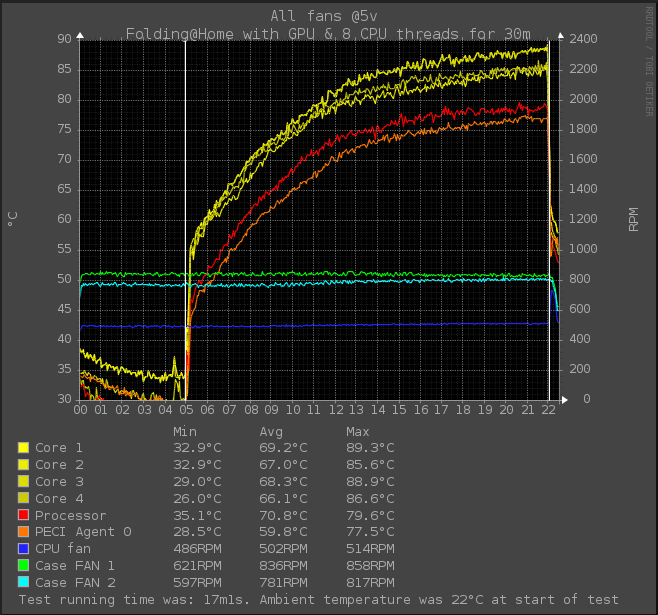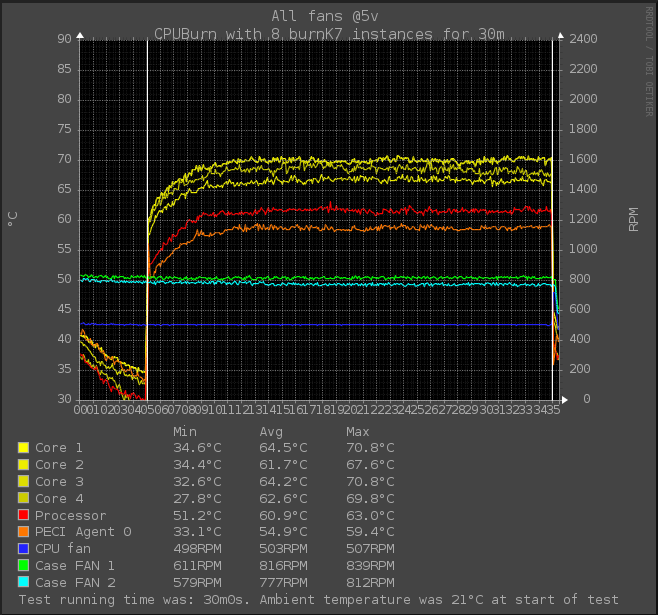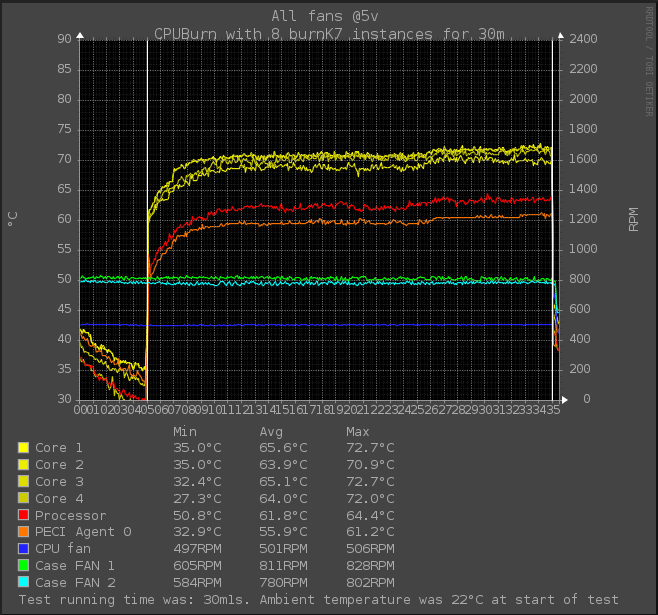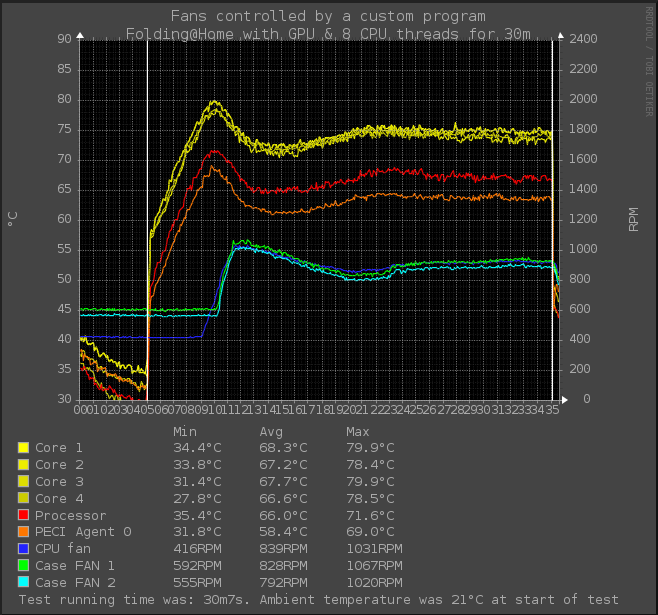2. Installation
Prolimatech PK3:
There isn't much to say about using PK-3. I heated PK-3 in hot water in a plastic bag (since PK-3 is quite thick and I red somewhere this should facilitate handling it). A large grain of the PK3 was put on the CPU (not spreaded!), and NH-C14 was installed. The included Noctua thermal paste was not used, since I had chosen to use the Prolimatech PK-3 instead before before buying the cooler.
System had some regular usage (for a few weeks) with this setup, including folding, before the test array was run – so in case PK-3 requires curing, it had happened before test. After running the tests, the heatsink was removed and I proceeded into changing the TIM for the Indigo XS.
Here are some pictures of the TIM interface pattern at removal:
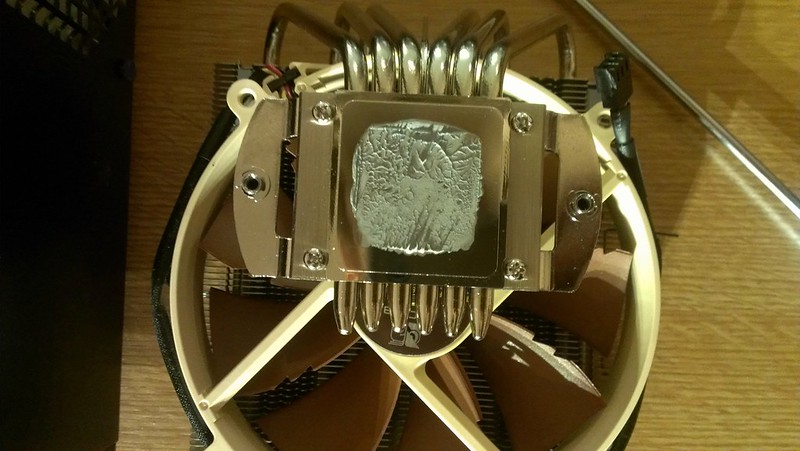
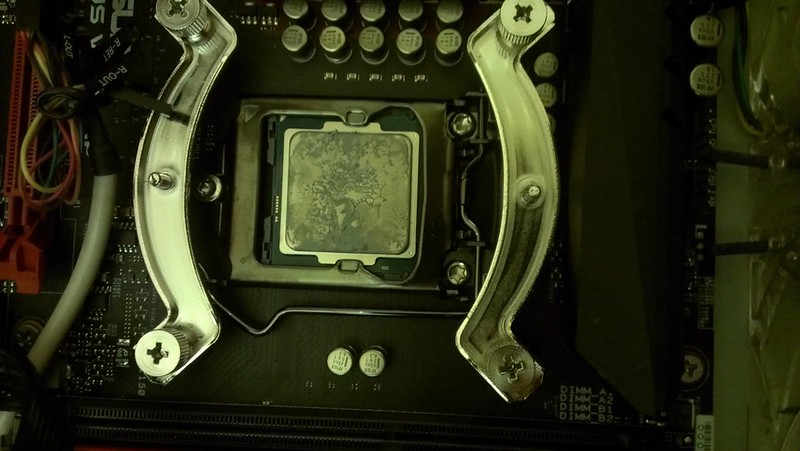
I believe I may have used slightly too much of PK-3, but otherwise it looks OK – though I haven't installed that many CPU heatsinks that I'd have loads of personal comparison points.
EDIT: If I'm not mistaken, the center part has more webby pattern than the sides? This means that the NH-C14 base is not optimally shaped?
Indigo XS
Indigo XS was installed according to the installation instructions provided by Enerdyne. The reflow procedure was not as easy as I thought, and there were a few complications – details below (sorry for the lengthy report!). In short,
in my case, on the 4790k and Asus Maximus VII Gene, reflow process seems to happen too easily and too quickly just by entering BIOS before a chance of booting into an OS! I newer saw the reflow pattern, though I believe I got proper reflow on my second attempt, and at last partial one the first.
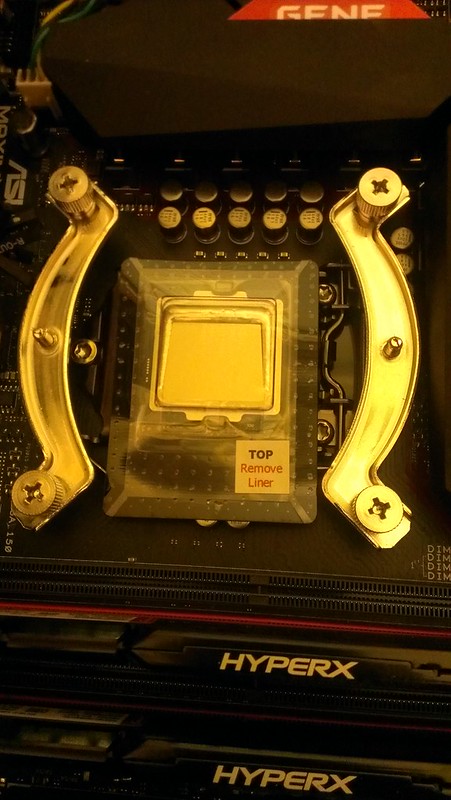 Indigo XS before NH-C14 installation
Indigo XS before NH-C14 installation
Before installing Indigo XS (with the Prolimatech PK-3 setup) I made sure I had stock voltage and CPU settings in BIOS. I left fans connected to the MB, since I planned on stopping them via software and running burnK7 in Linux. But at first boot, BIOS insisted that I had a new CPU installed (I had removed it to remove the old TIM properly from the heat spreader) – and just by entering BIOS, the CPU temperature was at 87°C! I believe this is probably because Asus Maximus VII BIOS does not use Intel P-states during bootup, as all OSes do instead. After booting into Linux, temperatures had dropped somewhat – to around 40°C, and this was idle temperatures! I didn't look at the situation for very long since it didn't occur to me that reflow might have already happened (and, I was not actually familiar what to expect for idle temperatures, as I had not run the CPU with stock voltages for a very long time).
So I proceeded with the ReFlow procedure as intended, and started ksysguard for temperature monitoring and burnK7 (8 instances). Ksysguard was showing my CPU temps, which shot up to 98-100°C immediately after running burnK7! I run i7z and saw that the CPU cores were all throttling, as intented to protect themselves. I initially run burnK7(x8 threads) for four minutes, but my nerves couldn't take it anymore. Temperatures dropped very fast after stopping BurnK7s, but not to as low level I'd expect. I re-read the instructions, which recommended up to 14-15 minutes for air coolers. So I re-ran it after a few minutes, this time for 15 minutes.
I never saw the reflow pattern, so I suspected an abnormal reflow. So I removed the heatsink, and this is the result:
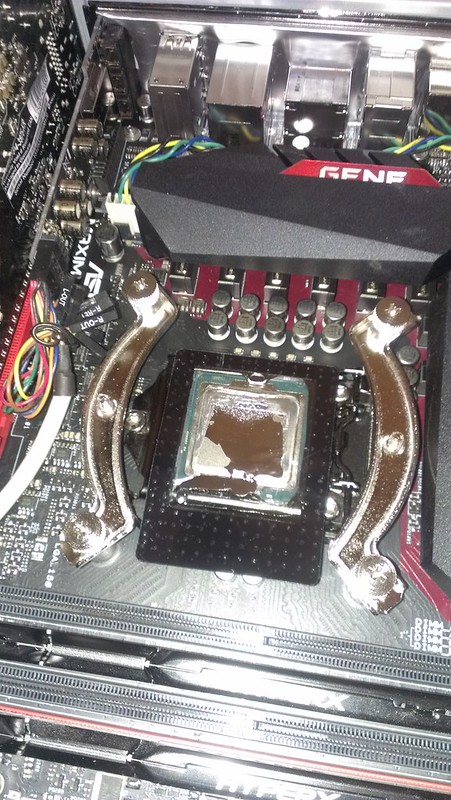 PIC of the CPU on the MB, with suboptimal reflow?
PIC of the CPU on the MB, with suboptimal reflow?
The corner part has missing TIM. Also there's an oblong metal blob on the plastic on the opposite side of where the TIM was originally.
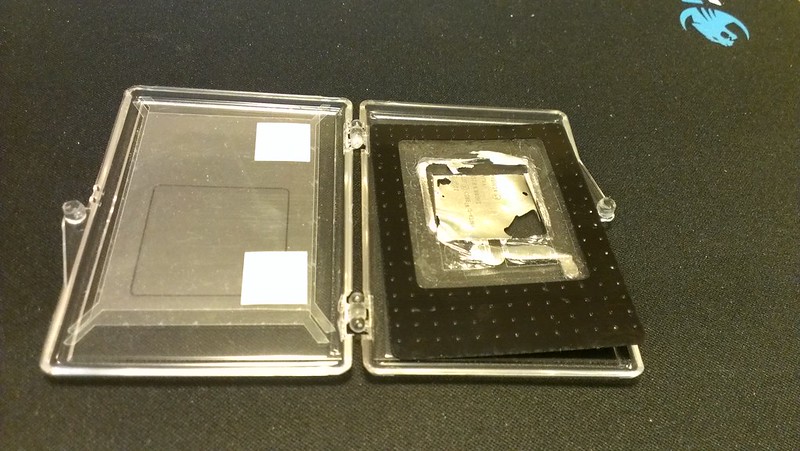 pic of the removed TIM, carefully peeled on my mousepad
pic of the removed TIM, carefully peeled on my mousepad
The small holes were intact before peeling, but got stuck on the CPU heat spreader. The larger "gap" at the corner is the place of improper reflow.
So: it seems reflow had occured, but some of the metal is on the plastic retainer of the Indigo XS, and a corner of the CPU heat spreader is bare. I thought that maybe reflow was abnormal because of interruptions in heat output (first heat spike caused by BIOS, and them maybe I stopped burnK7 too early on the first run, just as reflow was about to happen, and missed the change to see the pattern).
Second attempt:
So, change of plans for second run: I decided to disconnect all fans, put some rags inside the case, block all vents and re-try, this time with more controlled and consistent heat output without interruptions.
This time I didn't remove the CPU to skip any new-CPU installed messages by BIOS, so to minimize time spent in BIOS. I removed the small flakes of TIM stuck on the heat spreader, which was quite easy with the Enerdyne provided solvent; but it is always possible to get the flakes on the MB, however, so beware! I recommend taking the CPU off the MB while cleaning.
After booting into BIOS, it complained about fan failures! I had forgotten to disable fan monitoring in BIOS, and after I did that, BIOS was complaining about overheating CPU and not lettting me boot into Linux! I saw that the CPU was pegging around 89°C according to BIOS! I somehow managed to bypass the error (exit BIOS without saving) and boot into Linux, but: again, same thing: no reflow pattern after running burnK7 for 15 minutes.
Post-Indigo XS installation
So, now my hypothesis was that the reflow had occured too fast, even before I had time to run burnK7 in Linux, at least on my second run, but perhaps even on the first run. I let the computer cool down, rebooted, and did a burnK7 test with stock CPU settings and fans on – and, lo an behold, I seemed to get results indicating an adequate thermal interface! Nothing earth-shattering performance-wise, but adequate – also I hadn't run this CPU with stock voltage that much, so I was not sure what to expect. I confirmed my finding by re-enabling my undervolted profile, with which I was already familiar with, and noticed that temperatures were on-par with my previous installation, so I proceeded with the tests I had done on PK-3.
This is no guarantee that reflow had actually occured optimally. It is just good enough (seemed at least as good as Prolimatech PK-3). This is something that should be taken into account when interpreting the results! Since the TIM is working at least as well as the PK-3, I'm not going to disassemble the heatsink just yet. But in case I do later, I will update here with the findings of the reflow pattern of the second installation.
Since I had setup sensord in the background even during both of there ReFlow boots, I checked up my first attempts data later on. In hindsight, it seems that I could have achieved similar temperatures even with the first reflow attempts, but since I was worried about the processor, and suspected abnormal reflow, I didn't have the guts to try it for more than a few minutes. I chose to take a look at the TIM instead and see what had happened.
In hindsight, there are a few things one might want to take into consideration before installing Indigo XS (or equivalent):
- In case there is a BIOS setting for CPU power state or clock speed during bootup, choose the lowest setting In my case I had chosen "Boot Performance Mode: Max Non-Turbo Performance" = 4000MhZ. Had I chosen "Max-Battery" (=800MhZ) instead, this might have prevented unintentional ReFlow before having a change of booting into an OS. Some BIOSes might choose to use P-states even during bootup, which may eliminate this kind of issues - after all, the CPU would be idling 99% of the time at bootup.
- Make all the effort to not cause BIOS to spit out warnings (as in new CPU installed, fan failures) before installing Indigo XS, again to minimize time spent in BIOS, so as to not have ReFlow happening in BIOS. This way you have better chances of booting into an OS to make a controlled reflow with your chosen utilities
In my opinion, these should be added to the Indigo installation instructions. I haven't contacted them as of yet, though.
There's some more pictures of Indigo XS in this album
EDIT: I got reply (actually quite promptly in less than 24 hours - just haven't had time to update here) about my reflow procedure experiences. Here's part of their reply:
Enerdyne wrote:Yes, it is quite possible to partially/fully reflow IX/XS while in BIOS (higher power dissipation than OS); however, it is critical to maintain the recommended power (with no airflow/convection) during reflow without starting and stopping. We have seen similar voiding of the alloy when there is just enough power to initiate reflow (melting), thereby creating better thermal contact to the heat sink/waterblock; the increased contact will transfer more heat away from the interface and can solidify the alloy into an incomplete pattern (with voids); additional power/heating may not fill the voids.
I also suggested them adding some form of instruction about avoiding BIOS hassles, and thy said they are going to do that. But well see - and it may be difficult to figure out how to explain the issue in a concise manner in an instructions sheet, in any case.







